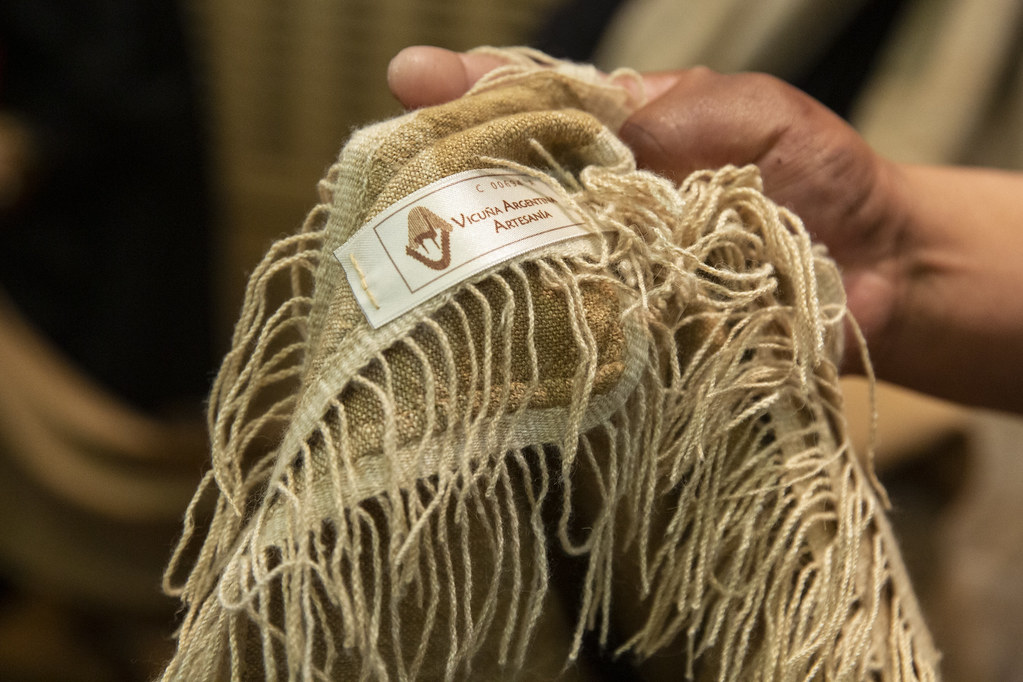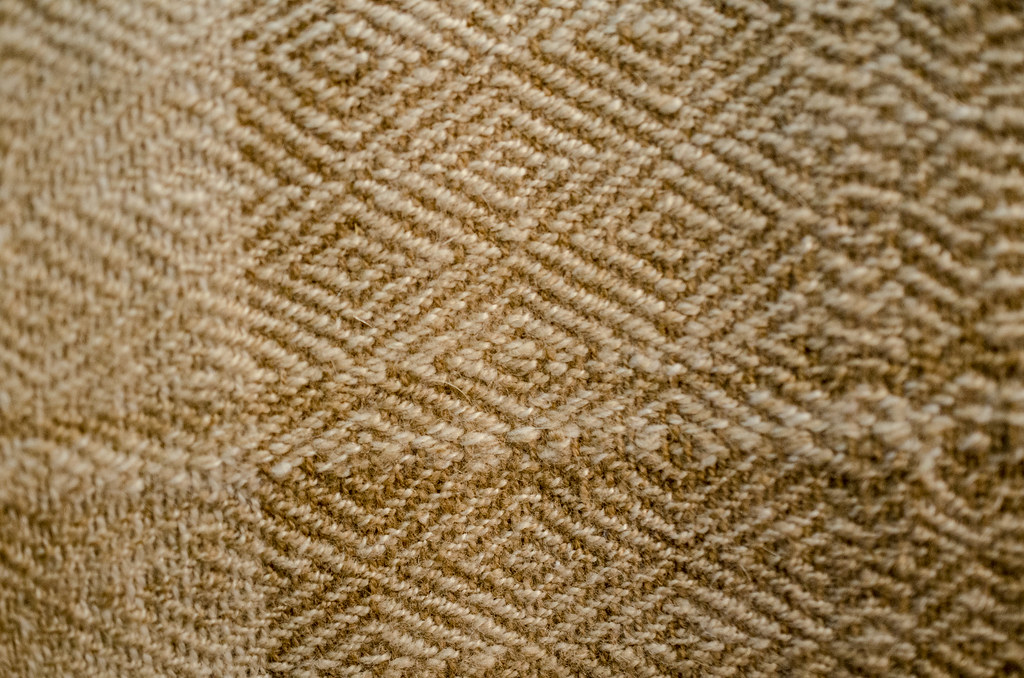Description
Los camélidos autóctonos sudamericanos silvestres son dos: los guanacos (Lama guanicoe) y las vicuñas (Vicugna vicugna).
Estos animales constituían una parte fundamental de las culturas prehispánicas, la vicuña en la zona andina como material para los tejidos de mayor importancia, y el guanaco aportando alimento y abrigo a las comunidades patagónicas selk’nam y aonikenk.
En 1973 los guanacos y las vicuñas argentinas se incluyen en la Convención sobre el Comercio Internacional de Especies Amenazadas de Fauna y Flora Silvestres (CITES). Se revalorizan estas fibras de cualidades excepcionales para el uso textil: son finas, suaves, aislantes térmicas, hipoalergénicas, repelentes al agua y con una paleta natural de colores que incluye blanco, negro, gris y una amplia gama de tonos tierra. De los ponchos de vicuña se dice que son tan finos que se los puede hacer pasar por el aro de un anillo.
La vicuña es considerada una fibra de lujo, una de las más caras y finas del mundo. Su uso es exclusivamente artesanal y la obtención la realizan de manera regulada las CAMVI (Comunidades Andinas Manejadoras de Vicuña), poblaciones organizadas para manejar y aprovechar de manera sustentable los recursos naturales de la Puna Jujeña. Este evento de captura y esquila, el Chaccu (del quechua arriar, juntar), reproduce una práctica ancestral. El proceso de limpieza, descerdado, hilado y tejido es totalmente manual. La elaboración de algunas prendas (como los ponchos, por ejemplo) puede llevar varios meses. Chalinas, ponchos y mantas son tejidos en telar criollo, con diseños de finas líneas que combinan los colores naturales del material, a veces con aplicaciones de bordado o terminaciones de rapacejo. Las y los integrantes de la cooperativa Mesa Local Laguna Blanca (Catamarca), se especializan en estos tejidos, con los que han ganado premios y reconocimiento internacional.
En 2017 entró en vigor la Marca Vicuña (CITES, 2016), la que debe ser solicitada por quien utilice la fibra para la fabricación de prendas.
El guanaco es una especie emblemática de la estepa patagónica, donde se agrupa la gran mayoría de estos animales en el continente. En 2019 la Secretaría de Ambiente y Desarrollo Sustentable argentina aprobó el Plan Nacional para el Manejo Sostenible del Guanaco. Su fibra es la segunda de más valor después de la vicuña.
El colectivo artesanal Guanaco Estepa (Río Negro) promueve la cadena de valor artesanal de su fibra fina: arreo y esquila en un entorno silvestre, hilado artesanal en huso, tejido en telar indígena, a dos agujas o a crochet. Producen mantas, ruanas, chalecos, guantes, accesorios y alfombras, con los colores propios del animal o con colorantes exclusivamente naturales. Los motivos se distribuyen en guardas por técnica de laboreo; se agregan en ocasiones terminaciones de flecos o chilla.
english
Vicuña and Guanaco
There are two indigenous wild South American camelids: guanacos (Lama guanicoe) and vicuñas (Vicugna vicugna).
These animals were a fundamental part of pre-Hispanic cultures: the vicuña in the Andean zone served as a material for the most important textiles, while the guanaco provided food and shelter for the Patagonian Selk’nam and Aonikenk communities.
In 1973, Argentine guanacos and vicuñas were included in the Convention on International Trade in Endangered Species of Wild Fauna and Flora (CITES). These fibres with exceptional qualities for textile use are revalued: they are fine, soft, thermally insulating, hypoallergenic, water repellent and with a natural palette of colours that includes white, black, grey and a wide range of earth tones. Vicuña ponchos are said to be so thin that they can be pulled through the hoop of a ring.
Vicuña is esteemed as a luxury fibre, renowned as one of the world’s most expensive and finest materials. Its utilisation is exclusively artisanal, and its acquisition is regulated by the CAMVI (Comunidades Andinas Manejadoras de Vicuña), organised collectives responsible for managing and ensuring the sustainable use of natural resources in the Jujuy Puna. The capture and shearing event, known as the Chaccu (derived from the Quechua word “arriar,” meaning to gather), faithfully reproduces an ancient practice. The entire process, involving cleaning, dehairing, spinning, and weaving, is meticulously manual. Crafting certain garments, such as ponchos, can span several months. Shawls, ponchos, and blankets are intricately woven on the Creole loom, featuring fine-line designs that harmonise with the natural hues of the material. Occasionally, these creations may incorporate embroidery applications or twisted-fringe finishes. The members of the cooperative Mesa Local Laguna Blanca in Catamarca specialise in these exquisite weavings, garnering prizes and international recognition.
In 2017, the Vicuña Mark (CITES, 2016) came into effect, and it is mandatory for anyone utilising the fibre for garment production to apply for it.
The guanaco is an emblematic species of the Patagonian steppe, where the vast majority of these animals are found throughout the continent. In 2019, the Secretaria de Ambiente y Desarrollo Sustentable (current Argentina’s Ministry of Environment and Sustainable Development) approved the Plan Nacional para el Manejo Sostenible del Guanaco (National Plan for the Sustainable Management of the Guanaco). Its fibre is the second most valuable after the vicuña.
The Guanaco Estepa collective (Rio Negro) promotes the artisanal value chain of its fine fibre: herding and shearing in a natural environment, artisanal spinning on spindles, weaving on indigenous looms, with two needles, or crochet. They produce blankets, ruanas, waistcoats, gloves, accessories, and rugs, with the animal’s own colours or exclusively natural dyes. The motifs are distributed in borders according to the weaving technique; fringes or chilla are sometimes added as finishes.





Reviews
There are no reviews yet.